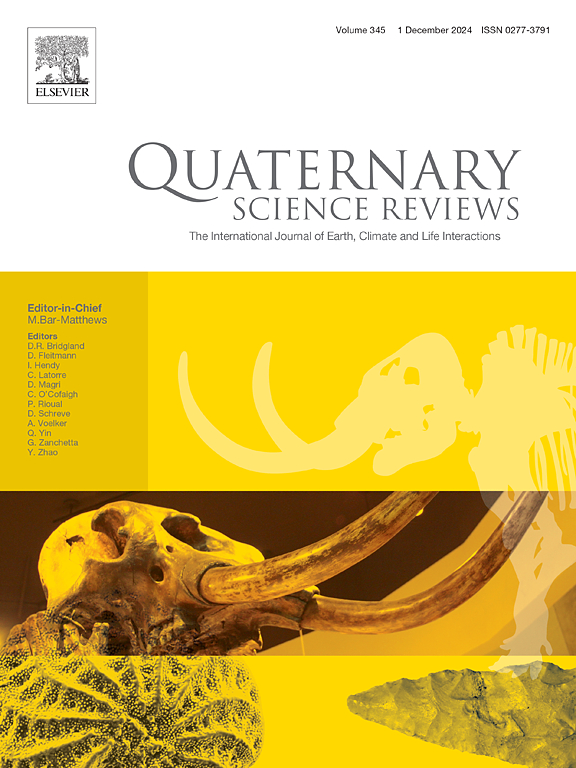第一个欧洲西北部的地层记录,包含整个冰缘冲积扇对(亚)轨道气候波动的响应的间冰期-冰期旋回
IF 3.3
1区 地球科学
Q1 GEOGRAPHY, PHYSICAL
引用次数: 0
摘要
冰缘冲积扇在欧洲西北部和中部很常见,它们的前全新世地层记录通常可以追溯到中更冰期晚期和晚更冰期(MIS3和mis2晚期)。迄今为止,保存下来的包括整个间冰期-冰期旋回的地层记录尚未被描述,因此不知道冰缘冲积扇在整个间冰期-冰期气候变化旋回中是如何反应的。本文重建了荷兰Eerbeek冰缘冲积扇沉积于萨利安晚期(MIS 6)至魏希塞利晚期(MIS 2),包括整个末次间冰期-冰期旋回(MIS 5-2)的演化过程。我们的重建是基于48个,高达45米深的钻孔和锥体穿透测试(CPT)原木,允许在Eerbeek冰缘冲积扇上建造8公里长的纵向和7公里长的横向截面。年龄控制是通过先前发表的17个风扇上两个钻孔的光学激发发光年龄和3个钻孔和附近一个现已废弃的采石场的14个14C年龄来提供的。在一个厚的晚萨利安(MIS 6)冲积扇记录之上,是一个4- 18 m厚的不同有机(主要是泥炭和腐植粘土)、硅质冲积扇(粗粒和中粒砂)、莱茵河(粗粒和中粒砂)和风成(主要是中粒砂)地层单元的交替。在Eemian间冰期(MIS 5e)、Brørup间冰期(MIS 5c)、Odderade-Ognon间冰期杂岩(MIS 5a)、中冰期(MIS 3)间冰期14、13、12和11间冰期以及MIS 2间冰期1a晚期,有机质水平表明扇的稳定性。碎屑沉积物表明,在海宁(MIS 5d)、瑞德斯托(MIS 5b)、奥格农(Ognon)杂岩(MIS 5a晚期)、早更新世(MIS 4)和中更新世上部(MIS 3上部)第13、12和11阶段有冲积扇活动。末次冰期(MIS 3晚期和MIS 2晚期)最冷和最干燥时期的沉积物不存在,并且在风成活动阶段之后,扇仅在MIS 2到MIS 1过渡阶段(静时1)重新激活。我们将末次间冰期-冰期旋回最冷时期没有扇活动归因于扇的向东方向使其对永久冻土融化不太敏感。Eerbeek扇活动的较冷的MIS亚阶段和阶段与永久冻土和/或季节性深度冻土的存在以及植被基本缺失的相对潮湿的气候相吻合。对下伏有机单元进行解剖的河道的存在表明,厄尔贝克扇最初是通过侵蚀的方式对从间坡到间坡的变化做出反应的。随着气候变冷和永久冻土/深霜的形成,扇转向冲积沉积。粗-细向上序列的持续存在表明,由于冻土条件越来越多,地表流增加的旋回与此有关。因此,扇地层学显示了在整个末次间冰期-冰期旋回中,暖-冷MIS亚阶段与间冰期-冰期气候旋回和冲积扇响应之间的直接耦合。本文章由计算机程序翻译,如有差异,请以英文原文为准。
The first NW European stratigraphic record containing an entire interglacial-glacial cycle of periglacial alluvial fan response to (sub)orbital climate fluctuations
Periglacial alluvial fans are common in northwestern and central Europe and their pre-Holocene stratigraphic records typically date back to late Middle Pleniglacial and Late Pleniglacial (late MIS3 and 2). Preserved stratigraphic records that include an entire interglacial-glacial cycle have, so far, not been described and it is thus unknown how periglacial alluvial fans responded during a full cycle of interglacial-glacial climate changes. In this paper, we reconstruct the evolution of the Eerbeek periglacial alluvial fan in the Netherlands which was deposited during the late Saalian (MIS 6) to late Weichselian (MIS 2) period, including the entire last interglacial–glacial cycle (MIS 5-2). Our reconstruction is based on 48, up-to 45-m deep borehole and Cone Penetration Test (CPT) logs that allowed the construction of an 8-km long longitudinal and a 7-km long transverse cross section over the Eerbeek periglacial alluvial fan. Age control was provided by means of 17, previously published, Optically Stimulated Luminescence ages of two boreholes on the fan, and 14 14C ages from three boreholes and a nearby, now abandoned, quarry.
Overlying a thick, late Saalian (MIS 6) alluvial fan record, is a 4- to 18-m thick alternation of distinct organic (mainly peat and humic clays), siliciclastic alluvial fan (coarse- and medium-grained sands), Rhine (coarse- and medium grained sands), and aeolian (mainly medium-grained sands) stratigraphic units. Organic levels indicate fan stability during the Eemian interglacial (MIS 5e), and Brørup (MIS 5c), Odderade–Ognon interstadial complex (MIS 5a), and Middle Pleniglacial (MIS 3) interstadials 14, 13, 12 and 11 as well as late MIS 2 interstadial 1a. Clastic sediments indicate alluvial fan activity during the Herning (MIS 5d), Rederstall (MIS 5b), Ognon stadial complex (late MIS 5a), Early Pleniglacial (MIS 4) and upper Middle Pleniglacial (upper MIS 3) stadials 13, 12 and 11. Sediments from the coldest and driest period of the Last Glacial (late MIS 3 and MIS 2) are absent and following a phase of aeolian activity, the fan was only reactivated at the MIS 2 to MIS 1 transition (stadial 1). We attribute the absence of fan activity during the coldest period of the last interglacial-glacial cycle to the eastward orientation of the fan making it less sensitive to permafrost melt.
The colder MIS substages and stadials in which the Eerbeek fan was active coincided with the presence of permafrost and/or a seasonal, deeply frozen soil, and a relatively humid climate during which vegetation was largely absent. The presence of channels that dissect the underlying organic units suggests that the Eerbeek fan initially responded to the changes from interstadials to stadials by means of erosion. As climate cooled and permafrost/deep frost developed, the fan switched to alluvial aggradation. The consistent presence of coarsening-fining upward sequences suggests a relation with cycles of increased overland flow due to increasingly more frozen subsoil conditions. The fan stratigraphy therefore shows the direct coupling between warmer-colder MIS substages and interstadial-stadial climate cyclicity and alluvial fan response over the entire last interglacial-glacial cycle.
求助全文
通过发布文献求助,成功后即可免费获取论文全文。
去求助
来源期刊

Quaternary Science Reviews
地学-地球科学综合
CiteScore
7.50
自引率
15.00%
发文量
388
审稿时长
3 months
期刊介绍:
Quaternary Science Reviews caters for all aspects of Quaternary science, and includes, for example, geology, geomorphology, geography, archaeology, soil science, palaeobotany, palaeontology, palaeoclimatology and the full range of applicable dating methods. The dividing line between what constitutes the review paper and one which contains new original data is not easy to establish, so QSR also publishes papers with new data especially if these perform a review function. All the Quaternary sciences are changing rapidly and subject to re-evaluation as the pace of discovery quickens; thus the diverse but comprehensive role of Quaternary Science Reviews keeps readers abreast of the wider issues relating to new developments in the field.
 求助内容:
求助内容: 应助结果提醒方式:
应助结果提醒方式:


